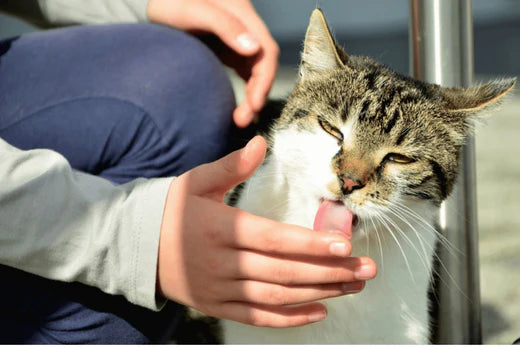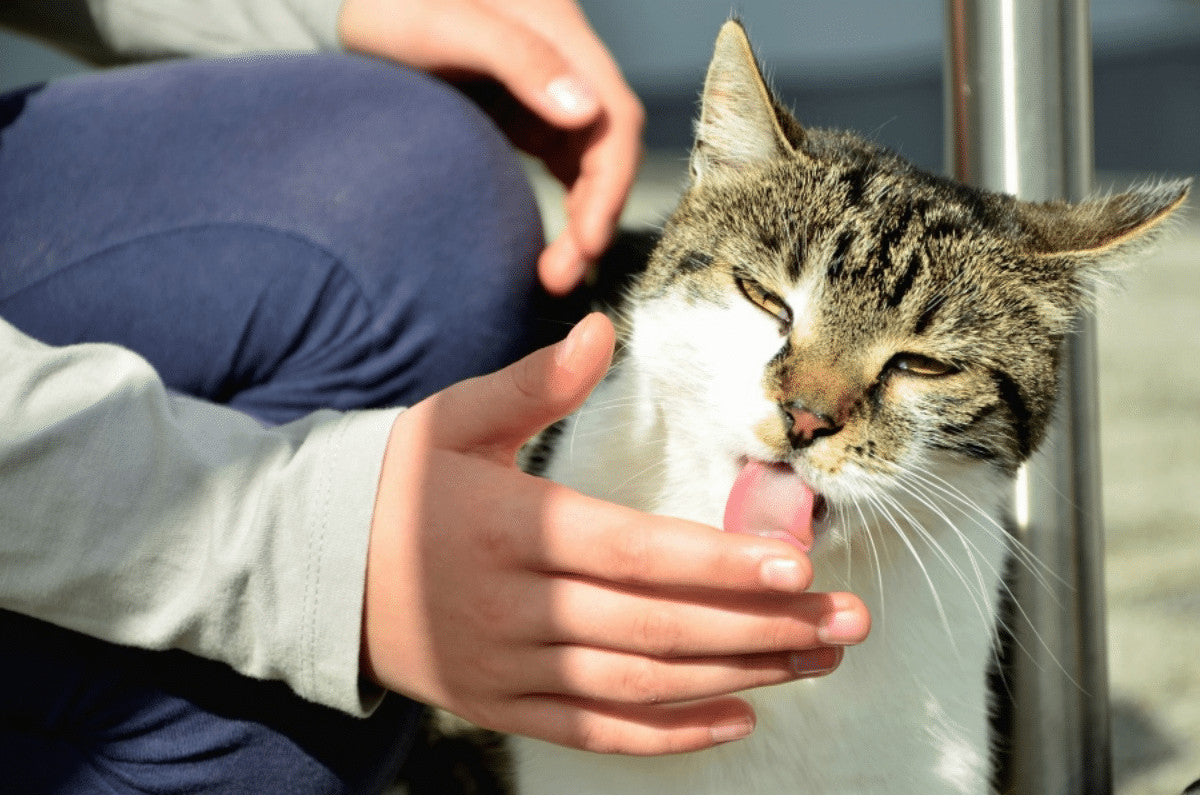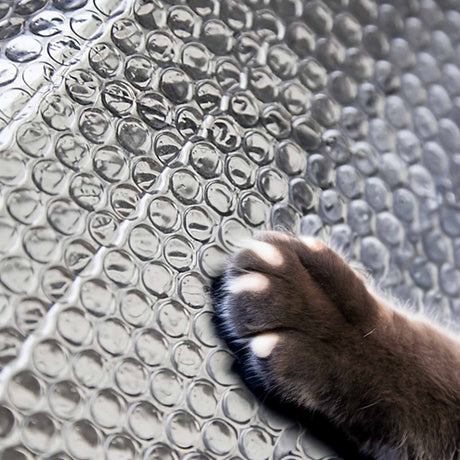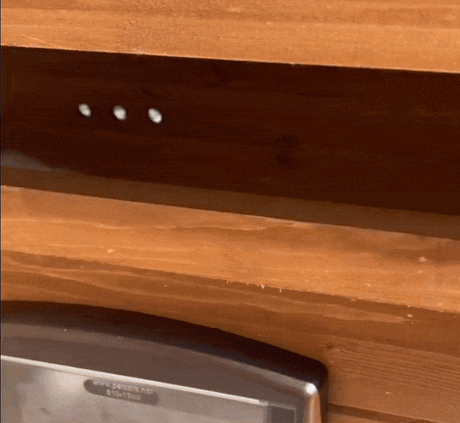Your first line of defence to stop it from spreading is diagnosing and treating it as quickly as possible. In this article, we answer the most popular questions about ringworm and your cat, including how to recognise it, what treatment is best and everything in between.
What Is Ringworm?
This common skin condition is a fungal infection that feeds on the keratin in a cat's fur, skin and nails. It's called 'ringworm' because the fungus creates circular ring-like lesions on your cat's skin, usually also associated with hair loss.
How Do Cats Get Ringworm?
Ringworm or dermatophytosis, as mentioned before, has absolutely nothing to do with worms. Instead, it is a fungal infection that is spread via spores on hair and skin that gets shed.
It is prevalent in kittens under 12 months because of their under-developed immune systems and long-haired breeds of cats. This is because the spores get trapped in their coats.
How Contagious Is Ringworm From Cat To Human?
Ringworm is highly contagious from cat to human, but it can also be passed onto other animals, including dogs, and it can be spread from human to human. Something else to keep in mind is that an infected person can pass the fungal infection onto animals.
But it doesn't end there. Dermatophytosis can also be spread when humans or animals are exposed to contaminated items, including food and water bowls, bedding and soil.
While anyone can catch ringworm, some people are more at risk. According to the CDC, these include younger children, people with compromised immune systems, and the elderly.
How Do You Know If Your Cat Has Ringworm?
It isn't always easy to spot ringworm, which is why you need to pay extra attention. The most common symptoms include:
- Dandruff
- Ring-like lesions on your cat's skin, especially on the head, forelegs, chest and down the back.
- Thickened patches of skin with hair loss around the area
- Crusty, inflamed patches
It is important to note that while other skin infections may make your cat itch, ringworm doesn't. If you notice any of the symptoms mentioned above, you will need to get your pet to a vet as quickly as possible.
How Do Vets Diagnose Ringworm?

With years of experience, vets can diagnose ringworm more accurately. They can also perform various tests to check that the infection is, in fact, dermatophytosis and not something else. Your vet may suggest one or more test.
Microsporum Canis
Using a microscope, your vet will check for fungal spores or Microsporum canis. This is done by applying a purple stain to the spores, which can then be seen under a microscope. However, because the spores can be challenging to pick up, this test is not always accurate.
Culture
To diagnose ringworm, the vet takes a sample of your cat's skin or fur and places it in a controlled environment to see if the spores grow. Although this is one of the most accurate tests around, it can take three weeks or more to get a result.
Wood's Lamp
This non-invasive method is quick and easy. With the use of a Wood's lamp, the vet will examine your cat for ringworm. Should the fungal infection be present, it glows a greenish-yellow colour. But because the light can cause other things, such as topical ointments and dead cells, to glow, it is often used in conjunction with another test for a more accurate diagnosis.
Polymer Chain Reaction Test
The polymer chain reaction test or PCR is the latest method vets use to test for ringworm. Similarly to the culture test, a sample of skin or fur is taken from your cat, but results are ready in a couple of days, unlike the traditional culture test.
Biopsy
Of all the diagnostic tests carried out, a biopsy is the most invasive, but it also the most accurate. A piece of skin is removed from your cat, which is then sent off for analysis. It takes two to three days for the results to come back.
Once the vet has confirmed it is ringworm, they will prescribe the most effective treatment. During this time, they will also ask (or check) you to see if you have been infected. If you have other pets, your vet may want to run tests on them, too, to check if the infection has spread.
How Do You Treat Ringworm On A Cat?

Using both an oral treatment and a topical shampoo or ointment kills the spores on the cat's skin or coat and treats any infection in your cat's system. More often than not, your vet will prescribe an anti-fungal medicine, such as Itraconazole, to treat the condition, as well as an anti-fungal shampoo. If you have a long-haired cat, the vet may recommend clipping its hair to treat the ringworm more effectively.
What Home Remedies Will Treat Ringworm In My Cat?
There are various home remedies you can use to treat your cat's ringworm. Let's take a look at the five most popular options.
1. Warm water and soap
One of the best home remedies for ringworm is warm water and soap. This will stop it from spreading and prevent other areas of the body from getting infected. Once you have cleaned your cat, you must dry the skin and fur properly, as the spores thrive in moisture.
2. Coconut oil
Another excellent home remedy is coconut oil. This is because it contains fatty acids that kill off the fungus by damaging the cell membranes. You should apply the oil to the infected areas at least three times a day.
3. Apple cider vinegar
You can also use undiluted apple cider vinegar to treat ringworm on your cat. Use a cotton wool pad to clean the infected area three times a day.
4. Aloe vera
Aloe vera doesn't only help treat the infection, but it also soothes inflamed or itching skin. You can apply aloe vera gel to the ringworm between three and four times a day.
However, a word of caution before you use any of these ingredients, other than warm water and soap on your pet, it's essential to test them on a small patch of your cat's skin to check for skin sensitivity or allergic reactions.
Do I Need To Quarantine My Cat With Ringworm?
Because ringworm is so contagious, you must quarantine your infected cat until it has been treated with an oral anti-fungal medication for a minimum of two weeks and at least four medicated shampoo baths. After this, your cat can be let out, although it is best to keep it confined to rooms without carpets that can easily be cleaned.
Should I Decontaminate My Home?
The spores that cause ringworm can live for up to 18 months in your home, so we strongly recommend decontaminating it. Vacuum carpets and couches and mop wooden or tiled floors with a chemical disinfectant. To keep your pets and children safe, ask your vet about an effective pet and child-friendly option.
Unfortunately, if your pet's bedding and toys can't be cleaned and disinfected, they will need to be thrown away. This is necessary to stop reinfections.
Will Ringworm Go Away On Its Own If Left Untreated?
You could choose to leave your cat's ringworm untreated. However, if you decide to go this route, be aware that it can take anywhere between nine months and a year to go away. During this time, your cat's hair will fall out, leaving it at risk of secondary infections, and you will also expose your family and other pets to infection.
How Can I Prevent Ringworm In My Cat?
The best way to protect you and your pet from getting ringworm is to wash your hands thoroughly before and after handling your cat. This will reduce the risk of you both becoming infected.
You should also keep your cat away from other cats in the neighbourhood and keep your home as clean as possible.
Although ringworm is common in cats and highly contagious, there are ways you can reduce the risk of infection. And if you or your pet is diagnosed with this fungal infection, there are treatments available to get rid of it.
If you found this article helpful, please feel free to share it with friends and family. And before you go, don't forget to like our Facebook page and sign up for our weekly articles for news, specials, discounts and members-only rewards.
Ringworm in cats is somewhat of a misnomer, mainly because it has absolutely nothing to do with worms. What it is, however, is a highly contagious zoonotic fungal infection that can be passed from cats to humans and human to human.
Your first line of defence to stop it from spreading is diagnosing and treating it as quickly as possible. In this article, we answer the most popular questions about ringworm and your cat, including how to recognise it, what treatment is best and everything in between.
What Is Ringworm?
This common skin condition is a fungal infection that feeds on the keratin in a cat's fur, skin and nails. It's called 'ringworm' because the fungus creates circular ring-like lesions on your cat's skin, usually also associated with hair loss.
How Do Cats Get Ringworm?
Ringworm or dermatophytosis, as mentioned before, has absolutely nothing to do with worms. Instead, it is a fungal infection that is spread via spores on hair and skin that gets shed.
It is prevalent in kittens under 12 months because of their under-developed immune systems and long-haired breeds of cats. This is because the spores get trapped in their coats.
How Contagious Is Ringworm From Cat To Human?
Ringworm is highly contagious from cat to human, but it can also be passed onto other animals, including dogs, and it can be spread from human to human. Something else to keep in mind is that an infected person can pass the fungal infection onto animals.
But it doesn't end there. Dermatophytosis can also be spread when humans or animals are exposed to contaminated items, including food and water bowls, bedding and soil.
While anyone can catch ringworm, some people are more at risk. According to the CDC, these include younger children, people with compromised immune systems, and the elderly.
How Do You Know If Your Cat Has Ringworm?
It isn't always easy to spot ringworm, which is why you need to pay extra attention. The most common symptoms include:
- Dandruff
- Ring-like lesions on your cat's skin, especially on the head, forelegs, chest and down the back.
- Thickened patches of skin with hair loss around the area
- Crusty, inflamed patches
It is important to note that while other skin infections may make your cat itch, ringworm doesn't. If you notice any of the symptoms mentioned above, you will need to get your pet to a vet as quickly as possible.
How Do Vets Diagnose Ringworm?

With years of experience, vets can diagnose ringworm more accurately. They can also perform various tests to check that the infection is, in fact, dermatophytosis and not something else. Your vet may suggest one or more test.
Microsporum Canis
Using a microscope, your vet will check for fungal spores or Microsporum canis. This is done by applying a purple stain to the spores, which can then be seen under a microscope. However, because the spores can be challenging to pick up, this test is not always accurate.
Culture
To diagnose ringworm, the vet takes a sample of your cat's skin or fur and places it in a controlled environment to see if the spores grow. Although this is one of the most accurate tests around, it can take three weeks or more to get a result.
Wood's Lamp
This non-invasive method is quick and easy. With the use of a Wood's lamp, the vet will examine your cat for ringworm. Should the fungal infection be present, it glows a greenish-yellow colour. But because the light can cause other things, such as topical ointments and dead cells, to glow, it is often used in conjunction with another test for a more accurate diagnosis.
Polymer Chain Reaction Test
The polymer chain reaction test or PCR is the latest method vets use to test for ringworm. Similarly to the culture test, a sample of skin or fur is taken from your cat, but results are ready in a couple of days, unlike the traditional culture test.
Biopsy
Of all the diagnostic tests carried out, a biopsy is the most invasive, but it also the most accurate. A piece of skin is removed from your cat, which is then sent off for analysis. It takes two to three days for the results to come back.
Once the vet has confirmed it is ringworm, they will prescribe the most effective treatment. During this time, they will also ask (or check) you to see if you have been infected. If you have other pets, your vet may want to run tests on them, too, to check if the infection has spread.
How Do You Treat Ringworm On A Cat?

Using both an oral treatment and a topical shampoo or ointment kills the spores on the cat's skin or coat and treats any infection in your cat's system. More often than not, your vet will prescribe an anti-fungal medicine, such as Itraconazole, to treat the condition, as well as an anti-fungal shampoo. If you have a long-haired cat, the vet may recommend clipping its hair to treat the ringworm more effectively.
What Home Remedies Will Treat Ringworm In My Cat?
There are various home remedies you can use to treat your cat's ringworm. Let's take a look at the five most popular options.
1. Warm water and soap
One of the best home remedies for ringworm is warm water and soap. This will stop it from spreading and prevent other areas of the body from getting infected. Once you have cleaned your cat, you must dry the skin and fur properly, as the spores thrive in moisture.
2. Coconut oil
Another excellent home remedy is coconut oil. This is because it contains fatty acids that kill off the fungus by damaging the cell membranes. You should apply the oil to the infected areas at least three times a day.
3. Apple cider vinegar
You can also use undiluted apple cider vinegar to treat ringworm on your cat. Use a cotton wool pad to clean the infected area three times a day.
4. Aloe vera
Aloe vera doesn't only help treat the infection, but it also soothes inflamed or itching skin. You can apply aloe vera gel to the ringworm between three and four times a day.
However, a word of caution before you use any of these ingredients, other than warm water and soap on your pet, it's essential to test them on a small patch of your cat's skin to check for skin sensitivity or allergic reactions.
Do I Need To Quarantine My Cat With Ringworm?
Because ringworm is so contagious, you must quarantine your infected cat until it has been treated with an oral anti-fungal medication for a minimum of two weeks and at least four medicated shampoo baths. After this, your cat can be let out, although it is best to keep it confined to rooms without carpets that can easily be cleaned.
Should I Decontaminate My Home?
The spores that cause ringworm can live for up to 18 months in your home, so we strongly recommend decontaminating it. Vacuum carpets and couches and mop wooden or tiled floors with a chemical disinfectant. To keep your pets and children safe, ask your vet about an effective pet and child-friendly option.
Unfortunately, if your pet's bedding and toys can't be cleaned and disinfected, they will need to be thrown away. This is necessary to stop reinfections.
Will Ringworm Go Away On Its Own If Left Untreated?
You could choose to leave your cat's ringworm untreated. However, if you decide to go this route, be aware that it can take anywhere between nine months and a year to go away. During this time, your cat's hair will fall out, leaving it at risk of secondary infections, and you will also expose your family and other pets to infection.
How Can I Prevent Ringworm In My Cat?
The best way to protect you and your pet from getting ringworm is to wash your hands thoroughly before and after handling your cat. This will reduce the risk of you both becoming infected.
You should also keep your cat away from other cats in the neighbourhood and keep your home as clean as possible.
Although ringworm is common in cats and highly contagious, there are ways you can reduce the risk of infection. And if you or your pet is diagnosed with this fungal infection, there are treatments available to get rid of it.
If you found this article helpful, please feel free to share it with friends and family. And before you go, don't forget to like our Facebook page and sign up for our weekly articles for news, specials, discounts and members-only rewards.








6 comments
Take Tea Tree Oil off the list, please.
Dangerous to cats.
Do not put it on your cat. Thank you.
Great reading
Question I have nursing kittens. Mother does not have ringworm but I suspect the kittens do. Can I still treat them with these methods? Don’t want to use the antifungal creams due to mother cleaning the kittens and her potentially getting I’ll from it.
NEVER EVER use tea tree oil or essential oils on cats. They are extremely sensitive to these strong oils and diluting them is not enough to be safe.
Tea Tree Oil is highly toxic and even deadly to cats, you should get that off this list!
Tea tree oil is poisonous to cats, please do not use it will cause kidney failure.